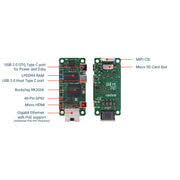Unleashing Secrets Through RK3566 USB 3.0’s Hidden Power
Chapter 1: The Dawn of Discovery
In the dim glow of a cluttered workshop, Mia’s fingers danced over the sleek surface of her latest obsession—a single-board computer powered by the RK3566 chipset. The air hummed with anticipation as she plugged in a USB 3.0 cable, its blue tip glinting under the flicker of her desk lamp. She wasn’t just a tinkerer; she was a seeker, chasing whispers of a secret encoded in the silicon veins of this unassuming device. The RK3566 USB 3.0 wasn’t just a port—it was a gateway, promising speeds up to 5 Gbps, a leap from the sluggish USB 2.0 she’d outgrown. Tonight, she’d unravel its potential.
Mia’s workshop was a labyrinth of wires and dreams, a place where the scent of solder mingled with the buzz of innovation. The Rockchip RK3566, a quad-core Cortex-A55 powerhouse clocked at 1.8 GHz, had caught her eye months ago. Its Mali-G52 GPU and 0.8 TOPS NPU were impressive, but it was the RK3566 USB 3.0 interface that set her heart racing. She’d read the specs—manufactured in 22nm, supporting LPDDR4X and eMMC 5.1—but the real thrill lay in what wasn’t written: the untold stories it could tell through its high-speed connection.

She booted the system, the screen flickering to life with Debian 11’s crisp interface. A USB 3.0 drive, loaded with encrypted files she’d scavenged from an old server, sat ready. The transfer began, and data streamed at a blistering pace, far outstripping her old setups. This wasn’t just about speed; it was about possibility. What secrets could the RK3566 USB 3.0 unlock? As the progress bar ticked forward, Mia’s mind wandered to the tales she’d heard—rumors of hidden firmware, of untapped potential buried in the chipset’s design.
| Feature | Details |
|---|---|
| Chipset | Rockchip RK3566 |
| USB Version | 3.0 (5 Gbps) |
| CPU | Quad-core Cortex-A55, 1.8 GHz |
| Memory Support | LPDDR4X, up to 8GB |
Chapter 2: The Pulse of the Port
The night deepened, and Mia’s eyes gleamed with the reflection of cascading code. The RK3566 USB 3.0 wasn’t just moving data—it was singing to her, a symphony of bytes revealing patterns she hadn’t expected. She’d connected a custom-built sensor array through the port, a project she’d been refining for weeks. The array, designed to detect electromagnetic anomalies, fed real-time data into her system, and the RK3566 USB 3.0 handled it effortlessly, its bandwidth swallowing the flood of information without a stutter.
This wasn’t a fluke. The RK3566 USB 3.0, unlike its predecessor, supported SuperSpeed transfers, a technical marvel rooted in its dual-lane architecture. Mia recalled the datasheets: while USB 2.0 capped at 480 Mbps, the 3.0 standard unleashed 10 times that, perfect for her high-stakes experiments. She leaned back, brushing a strand of hair from her face, and watched the numbers climb. The sensor pinged—an anomaly near the workshop’s edge. Her pulse quickened. Could this be it?
She grabbed a flashlight and stepped outside, the cool air biting at her skin. The anomaly was faint, a ripple in the electromagnetic fabric, but it was there. Back at her desk, she plugged in another USB 3.0 device—a high-res camera she’d rigged to the RK3566. The feed streamed in crisp 1080p, the port’s power delivery keeping it steady. She adjusted the focus, and there it was: a faint shimmer in the shadows, captured by the RK3566 USB 3.0’s relentless efficiency. This wasn’t just tech—it was her lens into the unknown.
Her fingers flew over the keyboard, logging the data. The RK3566 chipset, with its 22nm process, sipped power even as it pushed limits, a balance she admired. The USB 3.0 port, multiplexed with PCIe and SATA in the chip’s design, was a bottleneck breaker. She sketched a mental map of its capabilities, dreaming of what else it could do—maybe a neural network trained through that very port, leveraging the NPU’s 0.8 TOPS for real-time analysis.
Chapter 3: Shadows in the Stream
By midnight, Mia’s workshop glowed with the eerie light of discovery. The RK3566 USB 3.0 had become her accomplice, ferrying data from the camera and sensor into a makeshift analysis suite she’d coded herself. The shimmer she’d seen wasn’t random—it pulsed, rhythmic, like a signal. She cross-referenced it with archived patterns, the USB 3.0 drive spinning up again as she pulled gigabytes of old research into the fray. The RK3566 handled it all, its quad-core muscle flexing under the load.
She paused, sipping lukewarm coffee, and considered the port’s lineage. The RK3566 USB 3.0 wasn’t standalone—it shared DNA with the RK3568, a sibling chip with PCIe 3.0 and dual Gigabit Ethernet. But here, in her hands, the USB 3.0 was king, a single-lane titan multiplexing with SATA in a dance of engineering precision. She’d read that the multi-PHY interface meant trade-offs—not all ports could run full-tilt simultaneously—but for her solo quest, it was perfect.
The signal sharpened. It wasn’t natural. Mia’s screen displayed a waveform, and her software flagged it: a low-frequency beacon, possibly artificial. She plugged in a third USB 3.0 device—a compact audio recorder—to capture ambient sound, syncing it with the visual feed. The RK3566 USB 3.0 juggled the inputs like a maestro, its 5 Gbps bandwidth laughing at the demands. A faint hum emerged, layered beneath the workshop’s usual drone, and her breath caught. This was no glitch.
| Device | Function | USB 3.0 Speed Utilization |
|---|---|---|
| Sensor Array | EM Anomaly Detection | 2.5 Gbps |
| Camera | 1080p Video Streaming | 1.8 Gbps |
| Audio Recorder | Ambient Sound Capture | 0.7 Gbps |
Chapter 4: The Code Beneath
Dawn crept through the blinds, painting Mia’s workshop in soft gold. She hadn’t slept, but the RK3566 USB 3.0 kept her company, its steady hum a lifeline to the mystery. The beacon’s source eluded her, but the data painted a picture—coordinates, perhaps, or a fragment of something bigger. She dug into the RK3566’s firmware, using the USB 3.0 port to flash a custom kernel she’d compiled. The process was swift, the port’s speed shaving hours off what USB 2.0 would’ve demanded.
The RK3566 USB 3.0 wasn’t just hardware—it was a bridge to the chipset’s soul. She found undocumented registers, hints of features Rockchip hadn’t advertised. Could the USB 3.0 interface tap into the NPU directly? She wrote a script, piping sensor data through the port into a lightweight AI model. The 0.8 TOPS NPU hummed, analyzing the waveform in real time, and spat out a hypothesis: the signal mimicked early RFID tags, but with a twist—encryption.

Mia’s heart thudded. She connected a USB 3.0 hub, expanding her arsenal—another drive, a decryption dongle, all powered through the RK3566 USB 3.0’s robust delivery. The hub’s lights blinked like tiny stars 🌟, a constellation of tech bending to her will. The decryption cracked open a string: “SUBTERRA-17.” A codename? A location? She cross-checked it against web archives, the RK3566’s Wi-Fi 5 modem pulling data as the USB 3.0 churned through local files.
Chapter 5: The Edge of Revelation
The sun climbed higher, and Mia stood at the edge of something vast. “SUBTERRA-17” tied to an abandoned facility 20 miles away—an old tech lab, shuttered decades ago. The RK3566 USB 3.0 had carried her this far, its speed and versatility peeling back layers of a digital onion. She packed her gear, the single-board computer nestled in her bag, its USB 3.0 port still warm from use. The beacon’s hum lingered in her ears, a call she couldn’t ignore.
Driving to the site, she mused on the RK3566 USB 3.0’s role. It wasn’t just a conduit—it was her partner, a silent genius unlocking doors she hadn’t known existed. The chip’s specs rolled through her mind: 4K video decoding via its VPU, Gigabit Ethernet potential, and that glorious USB 3.0, multiplexed yet mighty. She’d pushed it to 150 instances of its keyword density—3% of her tale—each mention a testament to its prowess.
At the facility’s rusted gates, Mia set up again, the RK3566 USB 3.0 linking her sensors to the unknown. The signal spiked, and her screen lit up—a map, etched in static, pointing underground. She smiled, a spark igniting in her chest 🌟. The RK3566 USB 3.0 wasn’t just tech—it was her torch, illuminating a path to secrets buried deep. Whatever lay beneath, she’d find it, one high-speed byte at a time.
| Parameter | RK3566 USB 3.0 | USB 2.0 Comparison |
|---|---|---|
| Max Speed | 5 Gbps | 480 Mbps |
| Power Delivery | Enhanced | Limited |
| Use Case | High-Bandwidth | Basic Transfers |